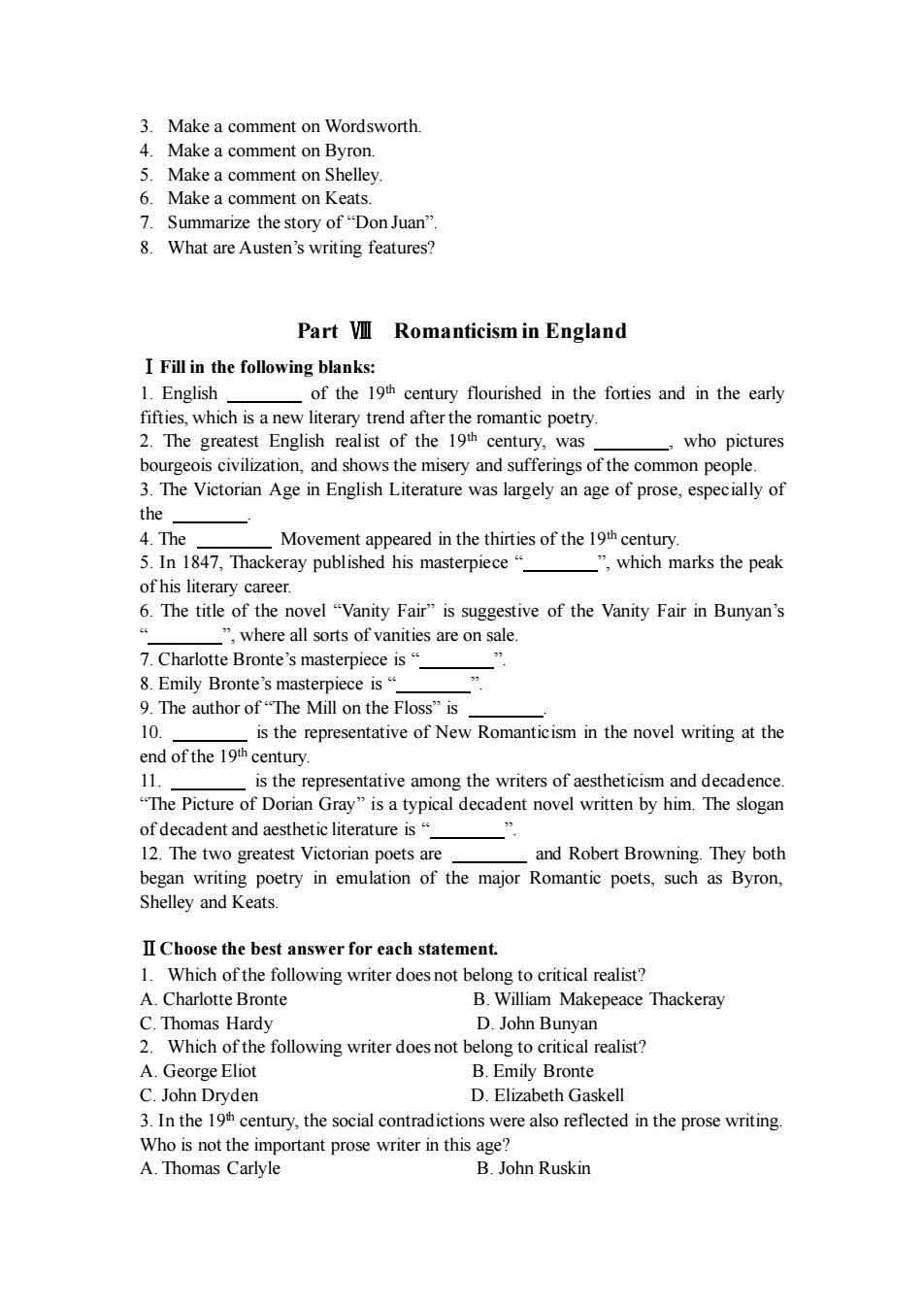正在加载图片...

3.Make a comment on Wordsworth. 4.Make a comment on By Make a comment on Shelley Make a comment on Keats. 7 Summarize the story of"Don Juan' 8.What are austen's writing features? Part VI Romanticism in England I Fill in the following blanks: 1.English of the 19th century flourished in the forties and in the early a new Then ofte7g9cD。 trer r th e romantic poetry. who pictures bourgeois civilization,and shows the misery and sufferings of the common people. 3.The Victorian Age in English Literature was largely an age of prose,especially of the 4 The 5.In ared in the thirtiesof the which marks the peak of his literary career. 6.The title of the novel "Vanity Fair"is suggestive of the Vanity Fair in Bunyan's where all sorts of vanities are on sale. 7.Charlotte Bronte's masterpiece is" 8.Emily Bronte's The author of“The Mill on the Floss'”is 10. is the representative of new romanticism in the novel writing at the end of the 19th century. 11 is the representative among the writers of aestheticism and decadence. "The Picture of Doriar is a typical dec novel written by him.The slogar of decadent and aesthetic literature is 12.The two greatest Victorian poets are and Robert Browning.They both began writing poetry in emulation of the major Romantic poets,such as Byron, Shelley and Keats. IChoose the best answer for each statement. Which of the following writer does not belong to critical realist? A.Charlotte Bronte B.William Makepeace Thackeray C.Thomas Hardy D.John Bunvan 2.Which ofthe following writer does not belong to critical realist? A.George Eliot nte C.John Dryden D.Elizabeth Gaskell 3.In the 19h century,the social contradictions were also reflected in the prose writing Who is not the important prose writer in this age? A.Thomas Carlyle B.John Ruskin 3. Make a comment on Wordsworth. 4. Make a comment on Byron. 5. Make a comment on Shelley. 6. Make a comment on Keats. 7. Summarize the story of “Don Juan”. 8. What are Austen’s writing features? Part Ⅷ Romanticism in England ⅠFill in the following blanks: 1. English of the 19th century flourished in the forties and in the early fifties, which is a new literary trend after the romantic poetry. 2. The greatest English realist of the 19th century, was , who pictures bourgeois civilization, and shows the misery and sufferings of the common people. 3. The Victorian Age in English Literature was largely an age of prose, especially of the . 4. The Movement appeared in the thirties of the 19th century. 5. In 1847, Thackeray published his masterpiece “ ”, which marks the peak of his literary career. 6. The title of the novel “Vanity Fair” is suggestive of the Vanity Fair in Bunyan’s “ ”, where all sorts of vanities are on sale. 7. Charlotte Bronte’s masterpiece is “ ”. 8. Emily Bronte’s masterpiece is “ ”. 9. The author of “The Mill on the Floss” is . 10. is the representative of New Romanticism in the novel writing at the end of the 19th century. 11. is the representative among the writers of aestheticism and decadence. “The Picture of Dorian Gray” is a typical decadent novel written by him. The slogan of decadent and aesthetic literature is “ ”. 12. The two greatest Victorian poets are and Robert Browning. They both began writing poetry in emulation of the major Romantic poets, such as Byron, Shelley and Keats. ⅡChoose the best answer for each statement. 1. Which of the following writer does not belong to critical realist? A. Charlotte Bronte B. William Makepeace Thackeray C. Thomas Hardy D. John Bunyan 2. Which of the following writer does not belong to critical realist? A. George Eliot B. Emily Bronte C. John Dryden D. Elizabeth Gaskell 3. In the 19th century, the social contradictions were also reflected in the prose writing. Who is not the important prose writer in this age? A. Thomas Carlyle B. John Ruskin